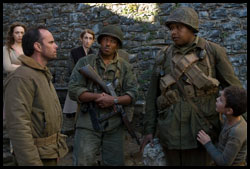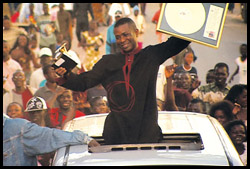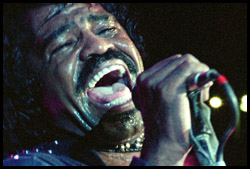 |

|
Miracle at St.
Anna |
|
Early on in this travesty of
a film, an elderly African American is watching a John Wayne WWII flick.
Spittling at the screen, he intones "we were there, TOO,
pilgrim..."
This, then, is Spike's answer to all those films that
"forgot" to include Blacks in their retelling of war tales. Much was made of
Spike's verbal attack on Eastwood for ignoring African American involvement in
his Iwo Jima/Flags of our Fathers projects. All this pre-release
drama and heavy handed introductions of character would, of course, be
completely forgiven if we were presented with a nuanced, intelligent, well
drawn tale of heroism.
Instead, we get what can be simply described as
the worst war film I've seen since the prurient Passchendaele. Now,
given that that was two days ago takes nothing from that sting - this is a
truly awful, horrendous film, best avoided if not downright
ignored.
Forgetting the dull plot, ridiculous situations and
boring-as-hell "McGuffin" (in the form of a statue head), the most abhorrent
thing about this film is that it is almost virulently racist. You've got
token characterizations throughout: forgiving the "cracker", southern white boy
who callously massacres his own men because he doesn't believe they've
succeeded in the first phase of their mission, the characterizations of the
black characters are the stuff of a Bamboozled-like Vaudeville
shtick. There's the over sexed light skinned black, the uncertain dark skinned
black who fawns at the site of the most gratuitous display of white boobs since
Dolomite. There's also the big, hulking giant, clinically retarded it
seems but strong as an ox and with a heart of gold, able to woo even the most
precocious of children with his feats of power.
Then there's the
language - forgetting the off-putting use of the term "nigger" as a form of
affectionate banter, this term is offensive in this context on aesthetic
grounds, if only because of its historical inaccuracy for the period. I'm not
sure if Spike was trying in some way to contemporize the slang (in the same way
that Milch uses "cunt" in Deadwood in place of "damn", as the force of
the former term has diminished while the latter continues to be, well,
provocative. Regardless, the writer/director shamefully parades the n-word,
making each soldier little more than characterizations of themselves, silly
pawns from just another rap video.
This is such a total failure, such a
total disappointment, that the trite and convenient ending is saved from being
risible by being merely pathetic and patently ridiculous.
The tale of
African American involvement in this conflict may certainly deserve more
attention than it gets, but, if anything, this film serves to do nothing less
than piss on the memories of those who actually served, making Black soldiers
seem like bumbling idiots incapable of keeping their dicks in their pants,
while engaging in militarily ridiculous activities and shlepping a
superstitious avatar in the form of a plaster, not-coincidentally white head.
Horrendous, simply horrendous. |
|
 |
|
Directed by: Spike
Lee
Grade:
FAIL |
|
|
Youssou N'Dour: I Bring
What I Love |
|
It’s hard to say
definitively, but certainly one of my earliest introductions to non-English
“World Music” was the collaboration between Peter Gabriel and
Senagalese sensation Youssou N’Dour. And what an introduction - his
soaring tenor seems to cut through any arrangement with bell-like clarity, a
distinctive instrument that can truly be said to be one of the planet's true
musical treasures.
With this documentary, we trace the creation of
N'Dour’s acclaimed Egypt album. Fusing a Cairo-based Arabic orchestra with
West African musical heritage, the album is a celebration of pan-African love
for shared religious convictions.
Films about the tension between
secular and religious music are hardly new, dating back at least to The Jazz
Singer as a topic for cinematic exploration. However, with this
contemporary look at two topics shrouded in misunderstanding, namely the
cultures of Islam and West Africa, we share in N'Dour’s troubles and
triumphs as this controversial album is received to both acclaim and
(initially) reticence.
This is a serious, heady film about important
topics, but it’s also at its heart a celebration, a joyous compilation of
live performances. The passion with which the musicians play this
“faith” music is extraordinary, and the sheer conviction demonstrated
by N'Dour to provide a positive international voice for his faith in the shadow
of contemporary struggles within the Muslim community is inspirational.
Attractively shot, intimate and unflinching, this is a wonderful document of a
musical legend as he tackles what proves to be his most personal work.
|
|
 |
|
Directed by: Elizabeth
Chai Vasarhelyi
Grade: A |
|
|
Derniere Maquis |
|
Pretentious, obnoxious film
about working in a pallet factory. Telling what should be an enlightening tale
about a boss who is imposing his Islamic faith upon his workers via the
construction of a mosque, we're instead inundated with long, drawn out images
of rows upon rows of red painted pallets, with forklifts scurrying back and
forth.
Sure, there are bonus marks again for a grown man who gives
himself a circumcision, but in the end this is a pointless, plodding film,
attempting to make some grand political statement but instead falling utterly
flat. |
|
 |
|
Directed by: Rabah
Ameur-Zaïmeche
Grade: D |
|
|
Soul Power |
|
By the time I learned about
the exploits of Muhammad Ali, he had long since moved from being a boxer to
being a political, historical figure, a celebrity afflicted with a medical
condition that effectively muted his fiery speech. It was the exemplary When
We Were Kings that first opened my eyes to Ali the boxer, the athlete, and
the most eloquent and engaging figure sports may have ever seen. That doc was
decades in the making, touching upon the political difficulties in staging the
fight in Zaire, and touching upon the music concert that was meant to coincide
with it.
Soul Power very much owes much of its power to the
earlier film - in any other context this concert would have been the highlight,
but given the sheer drama and improbability of the fight itself, this mega
concert really did become the sideshow. That said, there was some magnificent
music created here, and this film rightfully places the music at the
fore.
Directed by one of the editors of When We Were Kings,
Soul Power is more than simply B-roll footage from the previous doc. We
get a far better sense of the scope and scale of the show, of the logistical
challenges brought by pulling off a megaconcert in a challenging political
climate.
The highlight, surely, is the music. The African American and
Afro-Cuban artists are clearly revelling in this so-called "return", and the
performances (by the likes of James Brown, the Spinners, and Celia Cruz) are
all top notch. This is the early 70's, after these artists had honed their
groove, but before Disco would pasteurize the beat. These are hard driving,
funky performances, sweaty and intense. The reunited JBs are on fire, with
Maceo blowing his mind out with a righteous tone, and, of course, giving the
film its title. The Spinners, just climbing their ladder of success, look
somewhat out of place with their sweaty sideburns, but they bring their
harmonies to the fore. Miriam Makeba, who in the previous film was relegated to
snippits of her more intense gesticulations, is finally allowed to shine. Her
introduction to the so-called "Click Song" has a far more cutting introduction
than her similar intros with Belafonte, hinting not-so-subtly that the title is
forced upon her as the "colonialists" can't pronounce the Xhosa
words.
It is an unexpected delight, however, to find that B.B. King
shines brightest, with a downright unforgettable performance of the (now well
tread) "The Thrill is Gone". Injecting the blues with a laid back funk groove,
this is B.B. at the top of his game, a simply extraordinary
performance.
The audience is a wonderful part of the story as well.
Amused and certainly entertained by the more mathematical precision of James
Brown's groove, it is Mongo Santamaria's Cuban drumming that brings the
audience to ecstasy. Certainly there is no more direct connection between
African and North American music than the drum, and his dexterity on the bongos
cuts through any cultural division. The uproar after his solo is
electric.
Aside from the performances, we get greater insight into the
activities of the artists themselves (again, a funny and charming B.B. steals
the backstage show), and the film is peppered with extended scenes and
interviews with Ali. His opponent, George Foreman, is nowhere to be found
throughout the doc - his absence telling, if only that the artists themselves
were certainly on the side of "The Champ". That said, this (and other) absences
are more than made up by the prior doc, allowing this film to tell its story
unencumbered by the overriding narrative of the fight. It is thus at once more
intimate and more specific in its focus (absent as well are the talking-head
interviews).
Compelling, energizing, ecstatic, this is a show for the
ages, and the doc does a great job adding another layer to the already sublime
documentation of these events. |
|
 |
|
Directed by: Jeffrey
Levy-Hinte
Grade: A |
|
|
Deadgirl |
|
I have a simple demand for
exploitational, genre films like Deadgirl – if you’re going to
bother opening the proverbial pandora’s box, you might as well open it up
all the away. There’s nothing more frustrating than a half-assed horror
flick that thinks it’s scarier and gorier than it actually is, relying on
loud noises and spooky lighting to make up for terrible acting, poor
screenwriting, and a spoiled high-concept hook.
The hook in question is
that a bunch of rejects from the 90210 casting call are inexplicably digging
through an abandoned insane asylum, where they open up a sealed off door, only
to find a woman chained to a bed. We then learn that the woman is apparently
unable to be killed, prompting the lads to do the obvious – fuck her
relentlessly, poke holes in her for fun, and generally use her like some locker
room sock.
Right, so it’s that kind of movie…
The film thus has a truly repulsive and potentially
terrifying/enjoyable story line, but, aside from the obvious offensiveness of
the central plot line, it unfolds with such patently amateur results.
There’s zero suspense generated in any of the goings on, and the
twenty-something’s playing high school students seem utterly out of their
element. I spent more time worried about the “plumbing” issues than I
did feeling any sense of dread.
The film lacks either a sense of irony,
or the balls to go to the obvious limits that such a situation would present.
There’s lots and lots of creepy, truly sick-as-hell directions that the
film could have gone down, questions of gore and disgust that are touched upon
and then dropped for what amounts to a pedestrian, gormless tale. The end
result is neither disgusting enough to be shocking, nor interesting enough to
remain compelling during a midnight screening. |
|
 |
|
Directed by: Marcel
Sarmiento and Gadi Harel
Grade: D |
|
|
 |
|
